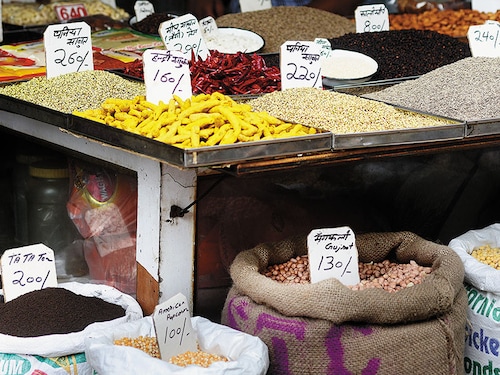Commodities are a real opportunity in 2018
Investing in base metals and crude oil through ETFs appears to be a good bet


The best part about investing in agri products is that the demand-supply cycle is easy to understand
Image: Ramesh Pathania / Mint via Getty Images
Interest rates in our banks are at multi-year lows. And returns in real estate, which have been subdued for years, are unlikely to witness a revival. In such a situation, commodities could emerge as the real opportunity for investors in India in 2018. Even for first-time investors, for whom investment in commodities might seem complex.
One theory in commodities has been around commodity price supercycles. The world has been through three complete supercycles over 150 years. Specific situations like increased demand from China can be the reason for the start of a new one. It fundamentally means a combination of supply constraints and increased demand. If that is true, then several commodities would be in a general uptrend for several years. But focusing on this may work better for index investing via commodity indices exchange-traded funds (ETFs) currently available abroad, and with a long-term outlook.
Investment in commodities could be through the physical form, that is take delivery of the product which will be stored in a warehouse, trade derivatives or even invest via ETFs, which are listed mutual funds traded on the equity exchanges and specifically meant for trading in gold.
As an asset class, commodities have rewarded investors during strong economic growth for the simple reason that increased demand equals increased prices. And since increased commodity prices cause inflation, it is a smart investment in such times. Also, the interplay between the assets is the best argument to invest in commodities.
Inflation leads to depressed equity prices while commodity investment returns are typically positive at such a time. This negative correlation decreases portfolio risk and can increase overall returns. In general, commodities are central to the global economy simply because they are the raw material, and any change in the price of commodities impacts the prices of all other assets like equity, bonds and currency. But because of the volatility and complexity, it has been the preserve of sophisticated investors.
However, by far, gold is the most popular investment commodity. Broadly, you can expect it to give the same return as inflation, which means the real value of your money is safe.
One can invest in the physical form, ETFs from equity exchanges or even gold bonds from the government. Silver, too, could be considered a good investment today because it is relatively cheaper than gold and is also used in industrial applications.
Though global and domestic metal stocks have been volatile after US President Donald Trump’s decision this month to impose high tariffs on imported steel and aluminium to protect US manufacturers, the outlook has, in general, improved for industrial metals. Increased infrastructure spending of the kind we see in India and has been promised by Trump in the US and elsewhere will see increased demand and therefore prices of copper, zinc and nickel could range upwards. This year, one could expect to see returns that are higher than any fixed deposit product offered by banks.
The issue here is the platform: In India, the only way to invest is through derivatives, which I would not recommend. But there is talk of making all this deliverable, just like gold or equity shares, and then this could become a real investment avenue. Meanwhile, investing through copper ETFs listed on the New York Stock Exchange (NYSE) is worth trying. Copper, a key barometer for the economy, is likely to witness higher prices as the global economic outlook brightens, which would lead to a boost in infrastructure, construction and electric cables. This year, one could expect double-digit returns.
undefinedOne could foresee a 20 percent jump in oil prices by the end of 2018[/bq]
Likewise, we have seen the price of crude oil go up in recent months. And the OPEC brotherhood is trying to continue with its production cuts to hold up prices. Better prospects for the global economic scenario will keep demand buoyant as oil is a key input in industry and agriculture. One could foresee a 20 percent jump in oil prices by the end of 2018. So is there a way to invest and benefit from it? Again, only by participating in derivatives trading in commodity exchanges in India, but that is fraught with risk as the trades are leveraged. So popular crude oil ETFs, again listed on the NYSE, are recommended to be the way in.
Interestingly, investment in some agri-commodities listed on India’s commodity exchanges provide a real opportunity. Based on the demand-supply mismatch and forecast, investment in guar (cluster bean) is a prospect today as could be jeera (cumin seed). Similarly, cotton with its global connect and domestic production, can be a target investment.
Given the increased demand for agri products on the back of growing domestic and export demand, several opportunities will continue to come up. It is necessary, like any other asset, to know what you are buying into and why, especially given the seasonal aspect in agricultural commodities. The best part about investing in agri products is that the demand-supply cycle is easy to understand.
If ever there was a reason to invest in commodities, it would be this year, considering returns from other asset classes such as equities and real estate are likely to be sluggish. The good news is that in India, mutual funds have now been allowed to invest in commodities and are the best investment vehicle. But, of course, investment basics remain the same. As a thumb rule, an allocation of up to 10 percent of investible surplus can be in commodities with half of that allotted to bullion.
The writer is president at Religare Broking, a securities and commodities firm in India
First Published: Mar 26, 2018, 14:52
Subscribe Now